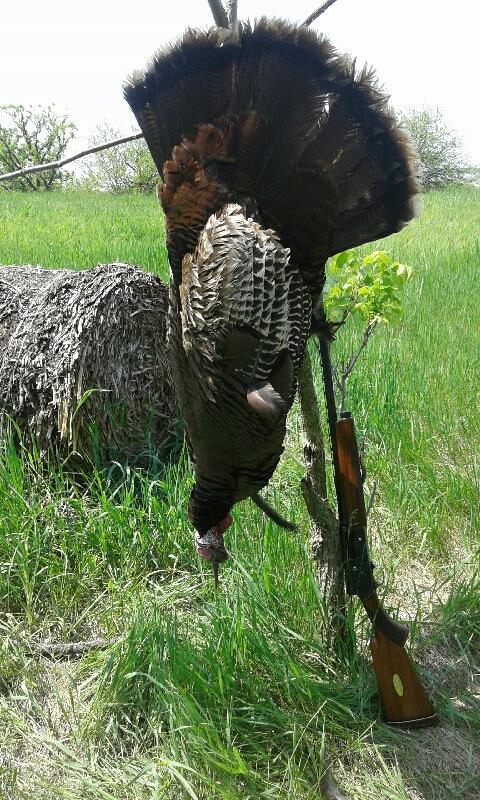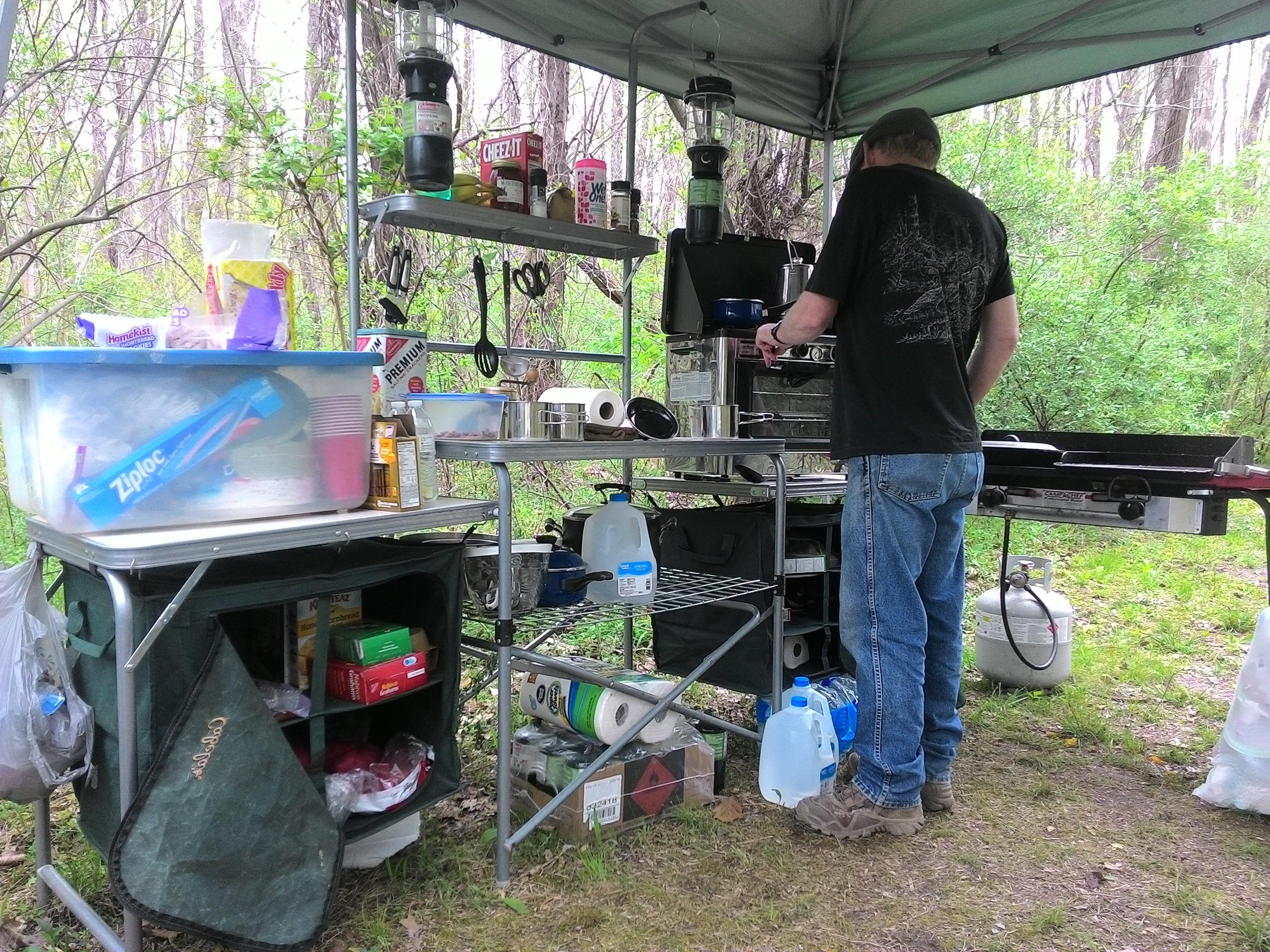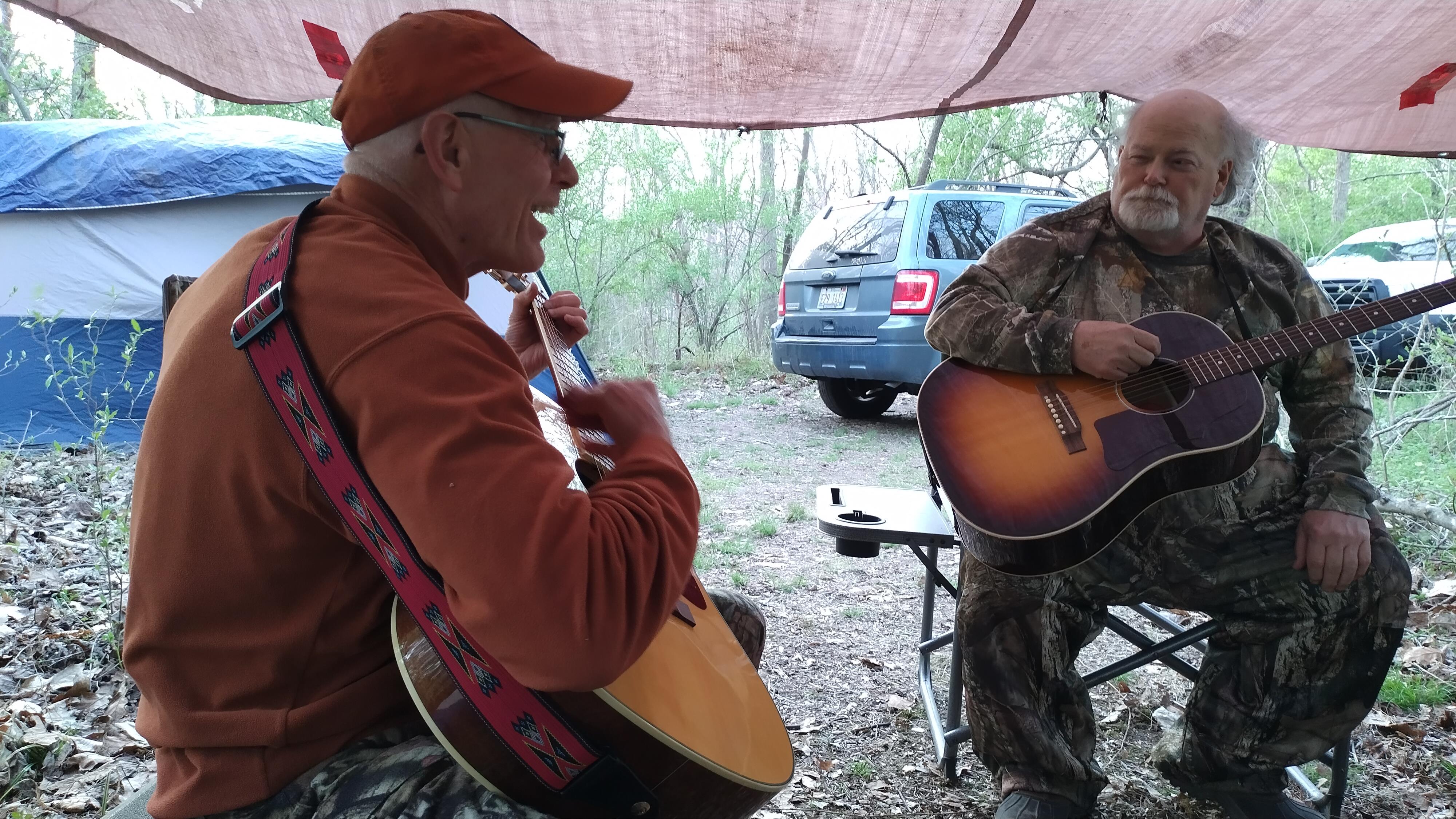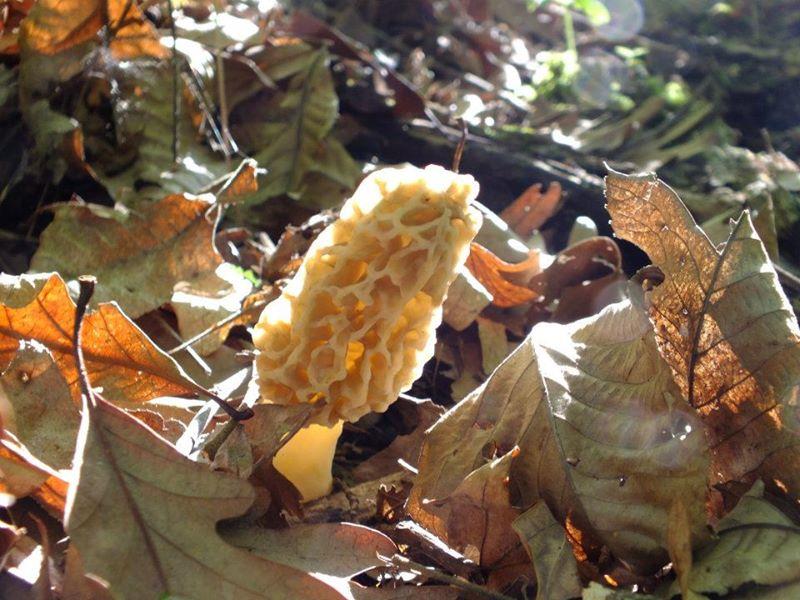




Only being able to hunt until 1:00 P.M. makes
turkey camp a little slower paced, yet exponentially
more frustrating than squirrel camp. Afternoons
are sometime spent hanging around camp,
playing guitar, hunting for Morels, or napping. I am
a fan of all and may indulge occasionally in all four
on a regular basis. Turkey camp isn’t necessarily
the place you’re going to hunt turkey at. Normally
the places you’ll be hunting is a fair distance from
turkey camp, turkey camp is the base camp for
your group of hunters to spend afternoons,
evenings, and nights getting much needed sleep
and relaxation. Being a centralized area for up to a
dozen hunters or so all having their own hunting
gear, sleeping systems, and tent it doesn’t hurt to
make camp comfortable. A sheltered common
kitchen along with a covered area to sit under out
of the sun or rain to eat, talk or play guitars,
harmonics, and other instruments will make your
stay a lot more comfortable. Everyone can share
the kitchen space for coolers and dry foods. Just
a couple of lanterns will allow enough light for
everyone under the shelter. When getting up at
4:00 A.M. most folks don’t stay up to late so it’s
easier to have one common area than to have
everyone doing their own thing keeping other folks
awake.
Early spring turkey season can be hit or miss, sometimes it’s warm, sometimes cold. Spring rains regularly
roll in, wind makes the turkeys less active, gobbling less making it harder to locate them, and even harder
to call them. Several of the State and National parks or forests in Illinois, allows morel hunters (which I am
one) to hunt Morels after 1:00 P.M. during turkey season, unfortunately Morel hunters aren’t aware of this.
On more than one occasion I have had a string of people walk right thru my turkey hunting set up, most are
totally unaware and very apologetic when they realize. Sometimes it makes for humorous stories, as in
when you are setting deep in prime turkey habitat and a Hooter’s waitress (in uniform) walks within a couple
of yards of you. When I loudly asked “Are Ya having any luck?” She was going somewhere fast, only she
didn’t know where. Her legs were moving Mach one, but her body was stationary. Having been a few years
ago I’m sure the grass eventually grew back from the trampling it received.
Early spring is a wonderful time to be in the outdoors, wildlife and birds abound in the fresh greenery of
timbers and woodlots. It’s usually cool enough in the mornings that the insects aren’t bothersome and just
sitting, listening and watching nature is reward enough for going. Seeing the blooming wildflowers, trees
starting to bud, or occasionally even blossoming to add a vibrant splash of color to the area. Reptiles and
amphibians are coming out of their stasis and you are lucky you may spot a salamander or tree frog
moving along on its way.
Don’t be fooled, turkey hunting requires some work
to be successful to even see or hear a turkey.
Locating turkey in the late evening by “roosting”
them is the approach I prefer. Just prior to dusk or
shortly thereafter, mimicking the call of the Barred
Owl will often to cause the turkey to gobble on the
roost revealing his general location. During the
spring of the year, gobblers will often shock gobble
to almost any loud noise, natural or artificial. I’ve
heard turkeys shock gobble at owls, crows,
roosters, cock pheasants, peacocks, thunder,
slamming car doors, gunshots, coyote howls, and
a myriad of other sounds or noises. Once you have
your turkey roosted, slowly and quietly sneak out
of the area and form a plan of action for hunting the
following day. Turkey hunting starts early in the
morning, sometimes VERY early depending on how far you have to travel to the hunting spot and still get
in to your hunting spot and get everything set up before it starts to get light enough to even see what
you’re doing.
It’s been my experience that the turkeys prefer to roost on the fingers of a ridge or somewhere along the
ridge itself and often land in the bottoms during fly down. I normally try to get setup in the bottoms hoping
the birds will fly down my way, but it’s a 50/50 chance at best of this happening. Using soft tree calls
sometimes helps to entice the gobblers to fly down in your general direction, but isn’t guaranteed by any
means. Once on the ground the gobbler may actively call to hens or they may remain completely silent
never making a sound slowly and cautiously heading to where they heard the “hen” calling. On more than
one occasion, I have had a bird walk up on me and only heard his footsteps in the leaves as he moves in.
Other times the gobbler may gobble occasionally while heading your direction, letting you know his
whereabouts. The most frustrating scenario is when the gobbler hangs up out of range or out of sight
gobbling his head off and never coming closer. Squacks, a hunting buddy, has a “fighting purr” call that he
uses in this situation, and that often persuades the gobbler to come in to range, the call replicates the
sound of two or more adult gobblers fighting, unfortunately the call no longer made. With the call no longer
being made and not having one myself, my tactic it to “purr” on the call once or maybe twice at most and
start rustling leaves to imitate the sound of a hen scratching in the leaves looking for acorn, bugs, or
whatever else is on the morning’s menu. After a while one of two things will happen, the bird will cease to
gobble and sneak its way into range or more often than not cease gobbling and leave the area.
On calling turkeys, everyone has their own way of working birds. I normally tree call a couple of times and
then remain as quiet as possible, sometimes this is enough. I few years ago I had a bird fly down to within
30 yards of me and head my way, that hunt lasted only a short time before I tagged out and headed back
to my vehicle, gobbler over my shoulder. Some hunters say that you can over call to a turkey and cause
him not to come in, I have personally had birds come in while not even carrying a call, but by just
“scratching” leaves. Other times I’ve had birds gobbling their heads off coming a quarter mile, while I
called constantly. In fact the first turkey I harvested was a 23 pound bird, with 1 1/4" spurs and an 11 1/2“
beard. I was only able to take him because of my wounded pride, after hunting hard every day of my
season without tagging a bird. I had birds that were gobbling and answering the my calls, but hung up for
one reason or another, one wouldn’t walk 10 yards around a woven wire fence, but would repeatedly try to
go thru it until he tired of it, another strutted about 75 yards out in the open on the far side of a small creek
and wouldn’t fly across. The story of my first harvest is that after hunting hard all week, the last day of
season I decided to throw in the towel early and was back home at 9:00 A.M. Having graduated from the
turkey hunting school of YouTube and watch numerous turkey hunting videos I decided to sit down, relax,
and lick my wounds. On my suggested vides was a very small, young man five or six years old, sitting in a
blind making a horrible racket on a box call when low and behold a gobbler comes running. With his dad
helping steady the shotgun, the young man harvested a nice gobbler and I don’t think he realized the recoil
of the shotgun and caused him to take an unexpected seat. After gathering his collective, he retrieved his
prize, which was only slightly smaller than the smile on his face. I sit there a minute, shut off the TV,
grabbed the Browning Gold, and a Lynch “World’s Champion” Box call. Wearing blue jeans and a black
long sleeve shirt headed back to my turkey hunting spot. Standing in the wide open on top of a pond dam,
I started raking the lid of the box call back and forth making a horrible sound when I was interrupted by a
turkey gobble. I had absolutely no clue that was going to happen or what I was going to do now that it had
happened. The only choice I had was to slide down the back of the dam and lay on my stomach. With my
shotgun beside me and my arms outstretched in from of me, I started raking on the call again only to be
interrupted by another gobble, only closer this time. I repeated this “style” of calling until I could literally
feel the bird’s gobble in my chest. I slowly got my shotgun in position and a couple of minutes later had my
first turkey tagged.
As I have gotten older and hopefully more
experienced I have learned a thing or two about
turkey hunting. The first being that all the videos I
watched, although helpful only showed the half
hour of a successful turkey hunt, not the countless
hours of unsuccessful turkey hunting. Second,
that real turkeys make some of the most horrible
non-turkey sounding calls I’ve ever heard. Thirdly,
that different turkeys in different areas act
differently and have to be hunted differently. I’ve
had birds that were so weary they left just because
their instincts told them something wasn’t right, I
have had jakes (immature gobblers) follow me
back to my vehicle, staying only a few yards away while I carried out a bird I harvested. They all had such
an overwhelming urge to tear in and fight the dispatched bird they totally disregarded me being there and
their own safety. The most important thing I’ve learned, is that no matter how much money you spend on
calls, decoys, blinds, and other hunting gear it’s not going to buy you success. If you’re trying to buy a
turkey, a supermarket is a lot more productive than the woods.
Turkey hunting for me starts from anywhere between 4:00 and 5:00 A.M., depending on how far I’m going
and what I’m taking. I normally travel as light as possible these days carrying only one box call, one pot or
slate call, several different strikers, and if using a decoy, one Jake decoy in half-strut. Early morning I set
up in the bottom where I hope the bird or birds may fly down to. I start with a couple of soft tree calls, until
fly down, then occasionally cluck, purr, and scratch leaves. Mid-morning, I try to slowly work my way to the
edge of the timber or along a field edge, cluck once or twice, put out my decoy facing the way I want any
gobbler to walk, (more on this later) and put the calls away. Late morning thru 1:00 P.M., I head back up to
the ridge or the fingers of the ridge, sit just below the top on the opposite side of the ridge or finger the
birds flew down from, place my decoy off to the side of my position nearest the side I’m hunkered down
on, again with the decoy looking over the ridge away from the side of the ridge I’m expecting the turkey or
turkeys to come from. I only call if I see a turkey some distance away or if I hear a hen call or a gobbler
gobbling.
Why I hunt the way I hunt. Let’s start with my decoy
choice and placement. There are a few reasons I use
a single Jake decoy, first if using a hen decoy, I feel
that an experienced or adult gobbler is more apt to
want and let the hen come to them. A stationary hen
decoy that refuses to move toward a “hot” gobbler
just doesn’t seem to be the natural way of things.
Second, a large adult gobbler decoy may actually
cause a less dominant bird to leave the area not
wanting to feel the wrath of the large dominant bird.
Occasionally however if there is a dominant bird in the
area it may very well come to the decoy looking for a
fight to drive the intruder away. My thoughts on this is
that there may be ONE dominant gobbler in the area, but several less dominant birds and those birds don’t
want any part of tangling with a big Ol’ Tom. With a Jake in half-strut, a dominant gobble will not hesitate
to show him whose boss and drive him away, while less dominant Toms that are trying to climb to a higher
position of dominance will want to assert his status on the stranger in the woods. Gobblers with the lowest
ranking and jakes will often come to the half-strut decoy for the mere fact that there may be strength in
numbers, and although turkeys are afraid of fighting, they’re not going to pick a fight they may not win or
end up injured even if they do win.
Decoy placement is as important to me as choosing the right decoy, first let me say even if you’re just
starting to turkey hunt spend a little extra money to get a decent quality of decoy, calls, and other required
or desired equipment. Don’t go by what the pros say and sometimes recommend, they normally don’t
spend their own money on equipment, talk to a few of your buddies that turkey hunt or even other hunters
in your area to see what they are using. On the subject of the professional hunters you see on TV, as
stated, you’re mainly going to see the successes, not the failures. Remember you may only be able to
hunt a couple of seasons in your area, the pros are being driven or flown all over the country on someone
else’s dime, with all the gear and lodging provided. I am not disrespecting pros or their skills they may
have, but the companies they work for have an agenda, that agenda is to make you spend your money on
their products. Some of these hunters get to spend countless days in the field hunting private places
loaded with birds, if we were capable of spending several weeks or months hunting our odds of success
and skill levels would improve substantially. Like anything, the more you are able to do it, the better you’re
going to get. The better you get, the more successful you will become.
Now back to decoy placement. As I said above, turkeys aren’t afraid to fight… if it comes to it, however the
mere sight of a larger dominant bird will often alone be enough to dissuade a lesser gobbler to make
track out of danger zone. If you have a decoy facing straight away from you, the incoming bird will
definitely be in its line of sight, if the decoy isn’t moving then the educated gobbler knows something’s up
and may silently slip away without so much of a sound or being seen. If the decoy is facing toward you
where the incoming bird has to walk past it, it will definitely draw the bird closer to you, most like between
you and the decoy if it gets that far. More than likely as walking by the incoming bird will flog or attach the
decoy from behind until it realizes something isn’t right. Even if the incoming bird gets between you and
the decoy you may very well damage your decoy if you do shoot, let alone damage it if the gobbler is
standing behind or next to the decoy. Another and maybe more important point is that you are sitting there
camouflaged and hidden making turkey sounds, if it happens that a less experienced hunter hears they
turkey call and tries to “put a stalk” on the bird, the first thing the hunter will see is the decoy between you
and themselves, possibly getting you injured or worse if he decides to shoot and hasn’t seen you. My
preferred decoy placement is in front of me, but off to the side by fifteen or twenty yards, looking at and
the 7-8 o’clock position with myself being at the 6 o’clock position, expecting the bird to come in from
anywhere between the 12 and 3 o’clock direction. This will cause the gobbler to walk across in front of
you, while keeping his attention on the decoy ahead of him. Even if the bird comes in from the 9 to 12
o’clock direction, it is more than likely that you will get a chance to shoot.
Now that someone knows where you’re going,
where you will be, and when you’re expected back
and you have your permits and licenses, know
where to hunt, have your shotgun, which you
hopefully patterned, turkey calls, decoys, and the
desire to turkey hunt what else do you need?
Good quiet camouflage clothing that blends in with
the area you’re going to be hunting in, and has
been washed in a UV killer to subdue the reflection
of ultraviolet light reflected by the brightener that a
lot of manufacturers use to make the camo look
good to the hunter. Don’t worry about scent or
cover scents, turkeys don’t. When choosing what
to wear, I would pick up both long sleeve and short
sleeve shirts, full length pants that tie or button at
the cuff to help keeps ticks and ants or the like
from crawling up your pant legs, a camo head covering or net, along with camo or net gloves, and a good
pair of water proof comfortable boots.
This will provide everything you need for the basic turkey hunt, don’t skimp on the camo, turkeys have
phenomenal eyesight and hearing. You want to reduce the chances of them seeing or hearing you as
much as possible, synthetic clothes that make swishing or other sounds when you walk or move will give
you away in a heartbeat if you need or have to turn to get into a better shooting position when a bird gets in
close. Other stuff you may want to consider is a turkey vest, once again sprayed with UV killer and having
a large game carrier on the back that will hold something the size of a turkey or a “strap” type carrier if you
prefer to carry the bird out over your shoulder. For your safety I would suggest getting a blaze orange
cover (bag) to put over your turkey so other hunters will see the bright color and not the turkey itself, a
blaze orange hat wouldn’t hurt as long as you have a place to stow both the bag and the hat while hunting.
A good turkey vest is soft and has enough pockets to quietly hold your hunting gear without it rattling
around making noise. You may want to take insect repellent, I use a Picaridin based repellent that doesn’t
seem to harm plastics or firearm finishes like Deet product sometime do. I also spray all my clothing,
boots, vest, socks and even underwear with permethrin to help ward off the ticks. You’ll need an ink pen
for signing your permit, and a small knife for cutting out the “V” notch of the permit here in Illinois. You will
want to carry a small flashlight as well for getting to your spot in the dark. If you need a bandana or
handkerchief, make sure it or in fact any of your equipment isn’t red, white, or blue. Red, white, and blue
are the colors that a turkey’s head can turn, so those colors may scream turkey to an inexperienced or
over anxious turkey hunter. You will want a container that is subdued and quiet to carry water in, clear
plastic water bottles stand out like a mirror in the woods. Depending on how long you are going to be
hunting you may want a soft sided container to carry a meal or snacks in, here’s a tip remove all the food
from the packaging before you go into the woods, the action of opening a package and the noise of the
crinkling paper is very noticeable in the woods. Try carrying your food or snacks in a camo bandana that
has been waxed with pure beeswax, it’s quiet, waterproof, and less reflective in the woods and can be
wiped down or shaken out when you get back to camp, depending on how picky you are about your food. I
would also suggest carrying a compass, whistle, small first aid kit (make sure it has any medication you
may need), and a few other survival items such as a space blanket matches or lighter, and rain poncho just
in case you misplace yourself for a while or overnight. Along with the emergency poncho that can be used
as a possible shelter, you’ll want a good rain suit to take along and perhaps a light jacket to be used early
in the morning when it’s cool. I always wear the jacket (normally open) and both the long and shirt sleeve
shirts going in, it’s easier to shed them and slip them in your game pouch as you need to that it is digging
them out in the dark. You may get warm hiking in carrying everything, but you may get very chilled after
sitting for a while. I realize that sounds like a lot to carry, but all of it will normally fit easily in your turkey vest
or pack.
This information should give you a basic understanding of what turkey camp is, a turkey hunting gear list of
what you may want or need, and how to start turkey hunt. Other than a few special items for turkey hunting,
a centralized kitchen and area to hangout in, your regular camping that you would normally use when
camping for a week or so should suffice just fine.